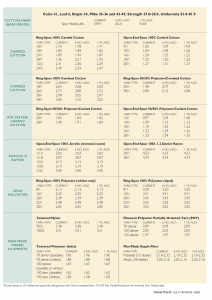Visits: 30
 By Jim Phillips, Yarn Market Editor
By Jim Phillips, Yarn Market Editor
Many spinners and fabricators are continuing to focus resources on providing personal protective equipment (PPE) to help first-line health care workers continue the fight against COVID-19.
For many companies in the fiber/textile/apparel complex, shifting resources from consumer goods to medical textiles has enabled them to weather the COVID crisis better than many other industries. Yet, even at the furious pace at which new products are manufactured, shortages of critical supplies are still common, and, in some cases, are becoming more severe. Part of the problem rests with limited PPE capacity in the United States and an over-reliance on China to fill the gap.
National Council of Textile Organizations (NCTO) President and CEO Kim Glas recently addressed the issue in testimony before the House Ways and Means Trade Subcommittee hearing on “Manufacturing and Critical Supply Chains: Lessons From COVID-19.”
“While domestic textile manufacturers have undertaken heroic efforts to confront the ongoing crisis, the onshoring of a permanent PPE industry will only materialize if proper government policies and other actions are put in place to help domestic manufacturers survive the current economic crisis and to incentivize the long-term investment needed to fully bring PPE production back to the United States,” Glas said. She outlined policy recommendations and concrete steps the government should take to address the long-term and short-term needs of frontline health care workers, patients and the general public.
“The time is ripe for a revival of American PPE textile manufacturing. It has already begun, but we are at a pivotal point. Without the necessary policy response and support, our recent progress will be undone just as quickly, and the China stranglehold over global medical textile supply will be locked in for the foreseeable future with no reason to invest here,” Glas said.
“The U.S. textile and apparel industry is ready, willing, and able to supply our country’s PPE needs now and for what lies ahead,” she added.
Reshoring PPE Production
A multi-industry coalition, representing the full spectrum of domestic PPE production released a statement in late July outlining policy principles and objectives needed for reshoring and safeguarding domestic PPE manufacturing.
The COVID-19 pandemic, which exposed severe shortages in PPE supply and an over-reliance on foreign sourced products, underscores how important it is for the U.S. government to incentivize, support and maintain domestic manufacturing capacity for PPE.
Association members, encompassing every segment of the U.S. textile, apparel and PPE supply chain, as well as unions representing workers, acted swiftly to convert manufacturing facilities and build supply chains virtually overnight to produce desperately needed PPE.
“We are united in our support of important principles that must be adopted in order to address our current public health needs and guarantee our nation is better prepared to respond to future emergencies,” the 21 associations said in the joint statement.
The associations are calling on Congress and the Trump administration to adopt principles outlined in the statement through legislation, executive order and other appropriate means.
Shortages Likely To Continue
Until there is enough U.S. capacity to supply PPE in necessary quantities, periodic shortages are likely to continue. “COVID-19 has put tremendous pressure on medical textile supplies,” said one industry analyst. “And with the worst of flu season coming up, the situation has the potential to become extremely critical. We can’t keep up with PPE needs for COVID. A bad flu season could be catastrophic.”
Recent surges in coronavirus cases have caused PPE needs to become even more critical. The U.S. Food and Drug Administration (FDA) on August 14 revealed its first list of medical supplies that are in short supply. The agency has required companies to report potential supply disruptions since May under the CARES Act.
The list does not reveal the product manufacturers, but lists that ventilators, respirators, masks, surgical gowns, gloves and sterile swabs are on short supply. As of August 14, more than 168,000 people in the United States have died from the virus and its complications, according to Johns Hopkins University. Overall, more than 5.2 million coronavirus cases have been reported in the United States.
The FDA announcement is in sharp contrast to an announcement by President Trump earlier in the day that lauded the work to increase the Strategic National Stockpile’s supply of some of the products that made the FDA list.
“We have tripled the number of N95 masks on hand to over 40 million, tripled the number of gowns to over 15 million and quadrupled the number of ventilators to 69,000,” Trump said during a news briefing.
While PPE supply shortages were common during the early stages of the pandemic, critical supplies began to increase. However, a spike in cases during August — particularly among those states that had reopened early or that have not implemented strict mask requirements and social distancing guidelines — resulted in additional shortages. Some medical facilities, particularly in rural area, say they have struggled to keep any inventory of critical supplies.
A large national organization that distributes donated equipment, GetUsPPE, said it’s received a massive increase in requests for PPE over the past two months, as the virus walloped the Sun Belt states and spread throughout the country.
There is increasing fear that the PPE shortage will not be temporary. According to The Guardian, shortages of personal protective equipment and medical supplies could persist for years without strategic government intervention.
Officials said logistical challenges continue seven months after the coronavirus reached the United States. Although the disarray is not as widespread as it was this spring, hospitals said rolling shortages of supplies range from specialized beds to disposable isolation gowns to thermometers.
“A few weeks ago, we were having a very difficult time getting the sanitary wipes. You just couldn’t get them,” Dr. Bernard Klein, chief executive of Providence Holy Cross Medical Center in Mission Hills, Calif., told reporters. “We actually had to manufacture our own.”
August 2020


